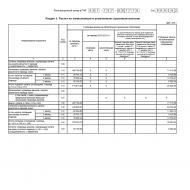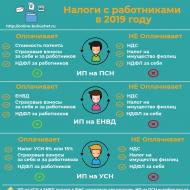
With deferred payment using commercial. Commercial loan terms. Why interest may be more profitable for the lender. What is a commercial loan
Thank you, that is, do you still need to specify the amount of the advance? It’s just that initially the contract was drawn up that he pays as it is shipped, and then he suddenly threw 2 large advances, but I’m still interested, Do I need to mention that the advance amount is not a commercial loan?
For your organization, as a supplier, prescribing the amount of the advance is not important, because. You are required to charge VAT on any prepayment received. But for the buyer, this moment is critical, because. if the prepayment amount is not registered, he is not entitled to deduct VAT from the transferred amount (even if there is an invoice for the advance).
In accordance with Art. 823 of the Civil Code of the Russian Federation, an advance in itself is a form of commercial lending. Therefore, regardless of whether you indicated in the contract that the advance is a commercial loan or not, in the event of a dispute, the court may equate the advance to a commercial loan with all the ensuing consequences. Therefore, it is better to provide in the contract that advance payment is commercial interest-free a loan to protect yourself from the accrual of interest for the use of a commercial loan in case of litigation. Please note: this wording does not exempt you from charging VAT on the amount of the advance payment received.
Rationale
From Civil Code RF
Article 823. Commercial credit
1. Agreements, the execution of which is associated with the transfer of ownership to another party sums of money or other things determined by generic features, a loan may be provided, including in the form of an advance payment, prepayment, deferral and installment payment for goods, works or services (commercial loan), unless otherwise provided by law.
2. The rules of this Chapter shall apply accordingly to a commercial loan, unless otherwise provided by the rules on the contract from which the corresponding obligation arose, and does not contradict the essence of such an obligation.
Installment or deferment of payment for goods (works, services) is a common occurrence in settlements between the supplier and the buyer (customer and contractor). But if the contract provides for the accrual of interest for installment or deferred payment, then we are talking about providing the buyer with a commercial loan and paragraph 1 of Art. 823, paragraph 4 of Art. 488 of the Civil Code of the Russian Federation. Let's see what features arise in its accounting and tax accounting, if both counterparties apply the general taxation regime.
What is a commercial loan
By itself, the condition of paying for the goods some time after the buyer receives it is not a commercial loan. The granting of a loan must be expressly provided for in the contract. clause 14 of the Resolution of the Plenums of the Supreme Court and the Supreme Arbitration Court dated 08.10.98 No. 13/14; FAS PO dated 17.01.2011 No. A49-3817 / 2010, dated 07.27.2010 No. A12-24970 / 2009; FAS SZO dated 09/01/2011 No. A56-63305 / 2010, dated 11/09/2010 No. A56-4656 / 2009; FAS MO dated May 23, 2011 No. KG-A40 / 3752-11. Then the supplier will be able to require the buyer not only to pay for the goods, but also to pay the amount of interest. In this case, the contract must specify Decree of the FAS PO dated November 19, 2009 No. А12-4139/2009:
- the amount on which interest will be charged;
- interest rate;
- interest period.
And do not confuse a commercial loan with the accrual of interest for late payment under Art. 395 of the Civil Code of the Russian Federation (responsibility for failure to fulfill a monetary obligation) Art. 395 of the Civil Code of the Russian Federation.
Commercial loan interest - will there be VAT?
When the goods are shipped, the seller charges VAT and issues an invoice for the cost of the goods specified in the contract. But should it be included in tax base the amount of interest on a commercial loan? And do I need to issue a separate invoice for interest? There are two approaches to this problem.
APPROACH 1. The amount of interest is included in the VAT tax base. Both the Ministry of Finance and the Federal Tax Service advocate for this option. Their main argument is that the interest on a commercial loan is related to the payment of goods in sub. 2 p. 1 art. 162 of the Tax Code of the Russian Federation; Letters of the Ministry of Finance dated November 29, 2010 No. 03-07-11 / 457; Federal Tax Service of May 12, 2010 No. ShS-37-3 / [email protected] . Once agreed with this and Decree of the FAS DVO dated January 27, 2010 No. Ф03-8066/2009.
If you agree with the regulatory authorities, then keep in mind that VAT calculated on the amount of interest cannot be presented to the buyer sub. "a" p. 7 sect. II Annex No. 3 to Government Decree No. 1137 dated December 26, 2011; Decree of the FAS VSO dated 05.08.2008 No. A33-3593 / 08-Ф02-3654 / 08. That is, when receiving interest from the buyer, the seller must determine the tax on their amount at the estimated rate of 18/118 or 10/110 sub. 2 p. 1 art. 162, paragraph 4 of Art. 164 Tax Code of the Russian Federation, draw up an invoice in one copy for yourself, register it in the invoice register (in part 1, without indicating the date of issue in column 2), register it in the sales book sub. "a" p. 7 sect. II Annex No. 3; p. 18 sect. Annex II No. 5 to Government Decree No. 1137 dated December 26, 2011 and pay tax to the budget.
APPROACH 2. VAT is not charged on loan interest. Interest on a commercial loan is a fee for using the loan. The buyer owes the seller money not for the goods, but for his later payment. A loan is a VAT-free transaction. This means that there should be no tax as a percentage sub. 15 p. 3 art. 149 Tax Code of the Russian Federation. Most courts agree with this. Decrees of the FAS SZO dated 01/27/2012 No. A26-4056 / 2011; FAS VSO dated 05.08.2008 No. A33-3593 / 08-F02-3654 / 08; 3 ААС dated November 20, 2008 No. А33-6473/2008-03AP-3211/2008; FAS PO dated November 15, 2011 No. А12-1917/2011.
But if you do not want to argue with the tax authorities, then, of course, it is safer to calculate VAT on the amount of interest. And since this VAT is not presented to the buyer, it can be taken into account when calculating income tax in other expenses x sub. 1 p. 1 art. 264 Tax Code of the Russian Federation.
And the buyer is not allowed to deduct VAT from interest, since an invoice for interest is not issued to him Letter of the Ministry of Finance dated December 29, 2011 No. 03-07-11/356.
How interest is treated for tax purposes
On the date of sale of goods salesman includes in income from sales proceeds in the amount of the cost of goods under the contract paragraph 3 of Art. 271 Tax Code of the Russian Federation. And interest is included in other or non-operating income on the last day of each month in which they are accrued. In the month when the loan is repaid - on the repayment date a paragraph 3 of Art. 43, paragraph 6 of Art. 250, paragraph 6 of Art. 271, paragraph 4 of Art. 328 Tax Code of the Russian Federation.
Customer recognizes interest as other or non-operating expenses on the same dates that the seller recognizes income, but within the limits, like any other interest on loans and borrowings m sub. 2 p. 1 art. 265, art. 269, paragraph 8 of Art. 272, paragraph 4 of Art. 328 Tax Code of the Russian Federation. And if the amount of interest paid turned out to be more than the amount of interest included in income tax expenses, the difference is not taken into account for tax purposes. paragraph 8 of Art. 270 Tax Code of the Russian Federation.
How credit transactions are reflected in accounting
At seller on the day of shipment, the debit of account 62 “Settlements with buyers and customers” and the credit of account 90 “Sales” (sub-account 90-1 “Revenue”) reflect revenue in the amount of the contractual value of the goods. Interest accrued on the last day of each following month (starting from the month of the loan) can increase revenue (a similar posting is made). Or you can account for them as other income, which is more convenient, since with this approach, accounting will be closer to tax accounting: account 62 debit - account 91 credit "Other income and expenses" (subaccount 91-1) sub. "b" p. 12, pp. 4, 7 PBU 9/99. Any of the proposed options must be registered in accounting policy organizations and clause 7 PBU 1/2008.
WARNING THE MANAGER
When paying for goods by installments or deferred payment it is better to do without interest at all, simply by increasing the cost of goods. This will simplify accounting: the buyer will get rid of the rationing of interest, as well as bring his accounting closer to the tax one, and the seller will avoid problems with calculating VAT on interest.
If you decide to calculate VAT on interest, then simultaneously with the calculation of interest, you make a posting for the amount of tax: debit account 90, subaccount 90-3 "Value Added Tax" (or account 91, subaccount 91-2), - credit account 76 " Settlements with different debtors and creditors”, sub-account, for example, “Deferred tax”. After all, until interest on the loan has been credited to your account, you are not required to pay VAT on them. In the balance sheet, deferred tax will be included in other liabilities. When the interest is transferred to you, you will need to make a posting on the debit of account 76 and the credit of account 68 “Calculations on taxes and fees”.
At buyer upon receipt of the goods, only its value under the contract is taken into account. And interest will be reflected in accounting as it accrues on the last day of each month and on the date of repayment of the loan as part of other expenses (debit of account 91 “Other income and expenses”, subaccount 91-2, - credit of account 60 “Settlements with suppliers and contractors” (or accounts 76) pp. 6, 7 PBU 15/2008; pp. 11, 14.1 PBU 10/99).
In accounting, there is no rationing of expenses. And if it turns out that in tax accounting you can take into account less interest expenses than in accounting, then there will be a constant difference and a constant tax liability(PNO) pp. 4, 7 PBU 18/02. In accounting, it is reflected by posting on the debit of account 99 “Profit and Losses” and the credit of account 68 “Calculations on taxes and fees”.
If you know that for some reason it will be difficult for you to pay for goods on time, then it is better to immediately agree with the counterparty on the calculation of reasonable interest from a certain day after delivery.
Our client attracted loans, the interest on which was taken into account in expenses for income tax purposes. Borrowed funds were spent on the purchase of goods, which the company then sold. The tax authority did not accept the amount of interest as an expense.
The inspectors justified their decision by the fact that the company provided interest-free loans to other organizations. Such loans were understood as a deferred payment, the tax authorities considered it a gratuitous commercial loan.
The company considered that the said grounds were not true. The conclusions of the Inspectorate are also not supported by specific norms of the RF Tax Code and established arbitration practice. We have prepared objections to the inspection report. As a result, superior tax authority canceled the decision of the IFTS.
Interest expenses are not related to activities aimed at generating income. The inspectors considered the use unconfirmed borrowed money for business-related purposes. It is concluded that the costs do not correspond to paragraph 1 of Article 252 of the Tax Code of the Russian Federation.
At the same time, the inspectors did not take into account the data on the accounting accounts Money. They confirmed that the borrowed funds were used exclusively by the company itself for its economic needs to carry out activities aimed at generating income.
text of objections
“The company is a trading enterprise. To carry out this type of activity, it was necessary to replenish working capital. For the purpose of which the company attracted borrowed funds. Any facts of the issuance of funds from received paid loans in the form of interest-free loans to other organizations or individuals missing.
This is confirmed by the data for the period under review on accounts 51 "Settlement accounts" and 52 "Currency accounts". It follows from the accounting registers that the funds raised were partly used to pay for the purchased goods and partly to pay the company's ruble expenses (customs expenses, payment for works and services Russian companies, wages, etc.).
Contracts have been reclassified. The inspectors indicated that most of the contracts were concluded with the provision of a deferred payment for a period of 14 or 30 calendar days from the date of delivery. Some contracts contained a condition on the establishment of a limit on goods "delivered on credit." The tax authorities reclassified supply contracts with deferred payment into commercial loan contracts with an unspecified interest rate for their use.
At the same time, the goods sold under these contracts were purchased at the expense of borrowed funds. From which the inspectors concluded that the borrowed funds were used to provide interest-free commercial loans.
text of objections
“The condition of paying for the goods for some time from the date of shipment is not an agreement on commercial loan. To do this, the parties must expressly indicate in the contract that deferment, installment payment, prepayment are commercial loans provided by one party to the other party. The amount and terms of the loan should be specified.
This approach is reflected, for example, in federal decrees arbitration courts Volga-Vyatsky No. А43-2403/2008-39-87 dated September 18, 2008; -C5, Povolzhsky No. A12-24970/2009 of 27.07.10 and No. A65-28147/2009 of 15.03.10, Moskovsky No. KG-A41/4721-05 of 15.06.05, No. KG-A40/9300 of 13.10.09 -09, dated February 18, 2009 No. KG-A40 / 39-09 districts.
The controversial wording does not confirm credit relations, since the agreements do not establish any elements of commercial lending. Contracts for the sale of goods, concluded by the company, do not determine the amount and terms of the loan. Taking into account Article 431 of the Civil Code of the Russian Federation and other terms of the agreement, the credit condition means that the supplier is not obliged to ship the goods to the buyer in excess of the agreed limit without receiving advance payments for such deliveries. In the absence of the fact of commercial lending to buyers, there are no legal grounds to present tax claims because of its gratuitousness and the use of borrowed funds to provide it.”
The inspectors gave their own assessment of the economic feasibility of spending in the form of interest. The inspectors proceeded from their subjective ideas about the expediency and meaning business transaction, about the activities of the company as a whole and about the terms of trade with counterparties.
At the same time, the actual profitability indicators for the sale of goods purchased at the expense of borrowed funds were not taken into account. The approach used by the inspectors completely contradicts the current legal position on the inadmissibility of assessing the concepts of reasonableness and economic justification of expenses. This led to the extensive application of Article 252 of the Tax Code of the Russian Federation.
text of objections
“The economic feasibility of expenses cannot be assessed on the basis of their expediency, rationality, efficiency or the result obtained, which, in turn, should be assessed only by the economic entity itself. Such conclusions are contained in the rulings of the Constitutional Court of the Russian Federation of December 16, 2008 No. 1072-O-O, of June 4, 2007 No. 320-O-P, of the Supreme Arbitration Court of the Russian Federation of January 19, 2009 No. 17071/08, etc.
Calculations made on the basis of the data contained in the inspection report confirm the economic feasibility of transactions to attract paid borrowed funds for the purchase of goods sold with deferred payment. The profitability of transactions for the sale of goods in the period under review ranges from 18.2 to 21.2 percent. Borrowed funds are attracted at 12.5 percent per annum. At the same time, the profitability of the transaction does not correspond to the rate annual interest, this is a one-time benefit of the company, taking into account the deferred payment for 14-30 days. During the period under review, borrowed funds made it possible to service a turnover that exceeded their value by five times.
The inspectors did not calculate the amount of the disputed costs arithmetically exactly and did not confirm it. The requirements of subparagraph 12 of paragraph 3 of Article 100 and paragraph 8 of Article 101 of the Tax Code of the Russian Federation have been violated.
In the opinion of the Inspectorate, the entire amount of interest accrued for the use of borrowed funds was recognized as overpriced. This does not take into account the facts economic activity. The audit report states that the borrowed funds are used to replenish working capital and to provide interest-free loans to buyers. However, there is no evidence that the deferment of payment for delivered goods (called “interest-free commercial loans”) was issued at the expense of borrowed funds.
In addition, a deferred payment was provided by the company for the entire cost of shipped goods. Meanwhile, borrowed funds are spent only on the purchase of goods. And the cost of goods is only a part of the amount of revenue.
text of objections
“From the moment when the company began to receive revenue from the sale of goods, it cannot be said that “commercial lending” - deferred payment - was provided to buyers through loans. The company used not only borrowed, but also own funds for the purchase of goods, and therefore for the provision of a delay to buyers.
Meanwhile, interest for the entire period of payment, when not only the first transactions, but also subsequent transactions, were excluded from expenses for the purposes of taxation of profits. Including those that the company has already carried out entirely at its own expense.
In addition, the attracted loans were mostly used for the purchase of goods. Therefore, the real cost of lending, which is referred to in the audit report, should be recognized precisely as the cost of goods sold (acquired at the expense of borrowed funds), and not the cost of shipped goods at sales prices (cost + markup).”
A commercial loan in a supply agreement is an opportunity to obtain a loan for favorable conditions within partnerships. To obtain maximum benefit and reduce the risk of losses, you should take into account the specifics of this agreement. In the article presented by us, all the features of commercial lending will be considered.
Commercial loan (concept and features)
A commercial loan is a type of loan, the terms of which may be included in the supply agreement. It can be provided by any of the parties to the transaction: the supplier - in the form of a deferred payment, the buyer - as an advance payment or advance payment.
A commercial loan differs from a bank loan in the following ways:
- Participants are parties to a general civil law contract, i.e. a commercial loan can be included in a contract, sale or other agreement providing for the transfer of financial amounts or goods with common characteristics to another participant.
- Any business entity can be a creditor.
- Credit can be provided in the form financial resources and in natural form.
- The fee for using this type of lending is initially included in the price of the goods.
In addition, an important difference lies in the amount of interest for using this type of loan: as a rule, they are much less than when obtaining a bank loan.
Types of commercial lending
According to Art. 823 of the Civil Code of the Russian Federation, allocated the following types commercial loan in the supply agreement:
- Advance payment - when the role of the creditor is performed by the buyer, who pays for the goods, which in the future will be provided to him by another participant in the transaction. The term of crediting is the period from the moment of transfer of funds to the receipt of products.
- Prepayment - in this case, the creditor is the buyer, who transfers to the counterparty a specific percentage of the cost of the product before it is actually received. After receiving the goods, the rest of the amount is transferred. The amount of payment and the term for receiving the goods must be specified in the text of the agreement.
- Postponement of payment - the role of the creditor in this case is performed by the seller, who delivers the product to the buyer, who pays for it after a certain time in one payment. Credit period - the period from the receipt of the product to full payment its value.
- Installment - here the creditor is the seller, providing the counterparty with the subject of the contract until it is fully paid. The difference of this type from the previous one is in the method of payment: it is not made at a time, but in certain parts according to the schedule specified in the text of the agreement or its annex.
Form of drawing up a commercial loan agreement
A commercial loan does not provide for the preparation of a separate document. The fact of its provision is simply included in the text of the supply agreement as a separate clause.
The document must also include conditions such as:
Don't know your rights?
- the cost of using the loan;
- method of its repayment;
- payment schedule.
Participants in a commercial loan agreement can be both individuals and legal entities.
If the loan repayment period is not provided for in the agreement, the borrower is obliged to repay it within 30 days from the date of the corresponding demand by the lender.
Interest, if not specified in the agreement, is calculated on the basis of the average rate of banking organizations in the territory of the subject of the Russian Federation. It should also be noted that the size interest rate limited by the refinancing rate of the Central Bank (this limitation determines the upper limit of possible interest on a commercial loan).
Possibility to include a condition on delivery on credit in an already existing agreement
Commercial credit is not always provided at the time of execution of the supply contract. If one of the participants is not able to pay for the received goods (service) within the period specified in the agreement, you can provide him this species lending.
Since there is no separate form for such a transaction, an additional agreement is drawn up to the current supply contract, which specifies the conditions for granting a loan (loan amount, interest rate). Also, the document should specify the method of repayment of the debt and the schedule for making payments. The additional agreement is considered valid from the moment of its signing by the parties to the agreement.
Pros and cons of commercial lending
A commercial loan in a supply agreement has both positive and negative sides, which should be taken into account when deciding whether to use it.
The benefits of this type of loan include:
- The size of the interest rate (it is significantly lower than in banking organizations).
- Ease of registration (all conditions are prescribed in the supply contract).
- No risk of loan refusal and the need to provide additional documents (all issues are resolved between counterparties).
In addition, commercial credit provides continuity cash flow which is essential for a successful business.
The disadvantages of this type of loan include:
- The limited amount of financing - both from the supplier and the buyer. In the first case, we are talking about the inability to cover the demand for a product (service), in the second - about the degree of solvency. This applies to those cases when the supplier is not able to produce a sufficient amount of products, and the buyer, in turn, does not have the necessary amount of finance.
- The risk of default by the borrower. The danger for the supplier lies in the possibility of the buyer refusing to pay the bills due to bankruptcy, for the buyer - in receiving goods (services) that do not correspond to the declared characteristics.
Thus, the terms of a commercial loan are entered directly into the supply contract. A commercial loan enables counterparties not to apply to a banking organization in order to obtain a loan, but to agree among themselves on mutually beneficial terms.
One of the main rules of business is that you cannot withdraw money from circulation. That is why legal entities use borrowed funds. A loan can be obtained not only in a bank or financial institution in the form of cash. One of the popular forms of financing - commodity - is defined by business entities among themselves as a commercial loan in a supply agreement.
What is a commercial loan
In a commercial loan, the object of the loan is a product or service. Commodity credit can represent both the supplier and the buyer. The first - in the form of a deferred payment, the second - as an advance or prepayment.
between commercial and bank loan there are a number of differences. Here are some of them:
- creditors in the first case can be any business entities, in the second - only financial institutions;
- the first is provided only in commodity or in-kind form, the second - exclusively in cash;
- the fee for a commercial loan is lower than for a bank loan (interest rate, commissions);
- the fee for using a commercial loan is included in the price of the goods, the fee for a bank loan or loan is a separate percentage or commission.
Types of commercial loan
The legislation of the Russian Federation provides for the following conditions for granting a commercial loan:
- advance payment - the buyer acts as a creditor, who provides money to the supplier or manufacturer for products that they are obliged to deliver to him after a certain time. Loan term - the period from the date of advance payment to the date of delivery of products;
- prepayment- the contract between the buyer and the supplier provides for a specific percentage of payment for the products until they are actually received. Prepayment is a loan, since the buyer receives the goods only after some time;
- deferred payment - delivery of goods to the buyer with the condition of transferring money (one payment) for the products after a specific time. In this case, the supplier acts as a lender, the crediting time is the period from the delivery of products to the moment of final payment for it.
- installment payment - the seller acts as a creditor, payment for the goods occurs later than its actual delivery. The difference between deferred payment lies in the method of payment - in this case, it occurs in installments in accordance with the payment schedule, which is also specified in the sales contract.
Depending on the method of granting a loan, the following forms of commodity financing are distinguished:

Contract form
A separate document form for a commercial loan is not provided. The parties that have agreed on payment or delivery of products simply provide for it as a separate clause of the main contract. In addition, the content of the document includes the price for providing a loan, the method and schedule of its repayment, etc.
Legislatively, the form of financing is regulated by the Civil Code of the Russian Federation. A commercial loan agreement can be concluded between legal entities or individuals. Additional documents from the Central Bank are not required for these transactions. Citizens enter into an agreement in writing, provided that the size of the transaction exceeds 10 times the minimum wage. Transactions between enterprises or companies are concluded only in writing.
If the interest rate and method of repayment are not specified, then the amount of payment is determined depending on the interest rate in the banking institutions of the region. The rate is valid on the date of payment by the borrower of the entire amount of the debt or part of it. The payment amount may also be limited. current rate refinancing of the Central Bank.
A transaction between parties can be interest-free if the following conditions are met:

The money is returned to the creditor within the terms stipulated by the contract. If there is no specific date, the borrower must repay the debt within 30 days from the date of presentation of the relevant request.
In order to avoid unpleasant situations, it is recommended to include the following clauses in the contract:
- term and amount of prepayment transfer;
- the amount and method of interest accrual;
indicate the form of financing - a commercial loan.
Advantages and disadvantages
Benefit from a commercial loan at low interest rates. Simplicity of registration is also important, since all the conditions for the provision of commodity financing are contained in the main contract. In addition, the speed of turnover of goods and money increases both for the supplier and the buyer.
The main disadvantage of such funding is its limited nature. On the one hand, the capacity of the manufacturer, which cannot cover the demand for the product, and on the other hand, the level of solvency of the buyer.
The supplier bears the risks associated with possible failure the buyer to pay the bills due to bankruptcy. The buyer runs the risk of receiving a low-quality product or not receiving anything.
Getting a loan from a bank - what you need to pay attention to: Video
















